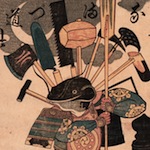|
Edgar Allen Ho posted:Also, unrelated, how likely is Cleopatra's suicide-by-snake to be a real thing? Are there other people supposed to have died that way? Every ancient source agrees that she died of poison, and the story that the poison was delivered by an asp appears very early, within a couple years of the event itself. Some sources, including Strabo who was a contemporary, were open to the possibility that the poison may have been delivered some other way (i.e. orally or by a poisoned oil on the skin). Some also thought (Strabo again) that she could have been poisoned by someone else rather than committed suicide. It's hard to say for sure what happened because she didn't die in public, but the snake story definitely isn't imperial spurting semen-tier scholarship, it was the accepted version of events throughout the ancient world so far as we know. There isn't anything innately implausible about her smuggling a snake into her house-arrest to kill herself and it's as well attested as anything in antiquity, so might as well believe it.
|
|
|
|

|
| # ? May 27, 2024 07:39 |
|
skasion posted:imperial spurting semen-tier scholarship I hope this stays a term
|
|
|
|
Since we're on the topic of Egypt, this popped up on my Facebook just now. http://foreignpolicy.com/2016/09/02...ional-identity/quote:On a cool Sunday evening in March, a geochemist named Sun Weidong gave a public lecture to an audience of laymen, students, and professors at the University of Science and Technology in Hefei, the capital city of the landlocked province of Anhui in eastern China. But the professor didn’t just talk about geochemistry. He also cited several ancient Chinese classics, at one point quoting historian Sima Qian’s description of the topography of the Xia empire — traditionally regarded as China’s founding dynasty, dating from 2070 to 1600 B.C. “Northwards the stream is divided and becomes the nine rivers,” wrote Sima Qian in his first century historiography, the Records of the Grand Historian. “Reunited, it forms the opposing river and flows into the sea.” I don't know enough about Egyptian or Chinese history to say whether it's all just BS, but it makes for an interesting read if you have nothing else to do.
|
|
|
|
Octy posted:Since we're on the topic of Egypt, this popped up on my Facebook just now. http://foreignpolicy.com/2016/09/02...ional-identity/ Phone posting but that sounds like utter bollocks to me, the Nile delta is dynamic system which today looks very different than it did 3+ thousand years ago. Today it has two distributaries, and according to Wikipedia Pliny the Elder says it had seven in Sima Qian's day and I really doubt this crank is using a map that accurately reconstructs the delta as it looked 4 thousand years ago.
|
|
|
|
what does he have to say about the shape of the relevant plateau, though
|
|
|
|
Thats pretty absurd. Xia might be semi legendary but they're the predecessor state of actual existing Chinese dynasties, and there's no reason to think they migrated halfway across the globe.
|
|
|
|
Mantis42 posted:Thats pretty absurd. Xia might be semi legendary but they're the predecessor state of actual existing Chinese dynasties, and there's no reason to think they migrated halfway across the globe. Typical Ivory Tower academic doesn't want to acknowledge my world-changing discoveries because they'll all look like idiots and they don't want to rewrite all of the textbooks that they're making mad bank from. Fat cat historians.
|
|
|
|
I'm reading Romance of the Three Kingdoms and I thought you guys would enjoy a historical precedent brought up by one of the characters: "Prince He of Chengyi committed 3000 offenses in just 28 days, and so Huo Guang deposed him." This Prince He sounds like just the sort of historical figure this thread loves.
|
|
|
|
Jeb Bush 2012 posted:what does he have to say about the shape of the relevant plateau, though I don't see anything in the article about plateaus? Anyway the quote from the Sima Qian is so short as to be almost impossible to interpret. For example without more context it seems reasonable to assume he's describing the ancient course of the Yellow River through the North China plain, which if you refer to the map in my post history quite distinctly pointed north-east during the period when the Xia civilization was presumed to have existed, and as this was in an era before large scale human modification of the channel likely would have had several small distributaries. It is a good article though, the body is mainly about Chinese historiography and explains how far western theories for the origin of the Chinese people arose from early nationalists looking for new narratives influenced by European research.
|
|
|
|
Squalid posted:It is a good article though, the body is mainly about Chinese historiography and explains how far western theories for the origin of the Chinese people arose from early nationalists looking for new narratives influenced by European research. Yeah these parts are interesting. It's a stretch, there's no evidence of the Xia existing at all though so anything about them is a stretch. I not-so-secretly enjoy anyone poking at the conventional narratives of Chinese historiography though since it's so bad. Edgar Allen Ho posted:I always think of places like Egypt as having already been completely excavated. It's easy to think that way but there's nowhere in the world that's completely excavated! We still find stuff all the time even in places like Rome and Athens, and space archaeology has changed everything because it's turning up literal thousands of completely unknown new sites all over the place. If I had to do over again I would have gotten into space archaeology, it wasn't a thing yet when I was in college and it's the most exciting field now. That or stuff in the Americas, which I had no interest in at the time because I grew up in the US and don't really find the native history there exciting. But you go down to Mesoamerica or South America and there are huge cool empires and stuff, and that field is exploding right now so whoops.
|
|
|
|
I work with lidar for a much less interesting reason but I'm glad my chosen field has detected a bunch of ruins in the Amazon
|
|
|
|
Edgar Allen Ho posted:
I can't recall the source, but I believe it was a Greek soldier who went suddenly blind at the onset, or maybe during, an ancient battle. Apparently stress induced blindness is a thing.  I finally started watching Band of Brothers and it was shown there as well. I finally started watching Band of Brothers and it was shown there as well.FOUND IT! https://rogueclassicism.com/2009/07/29/marathon-post-traumatic-stress-disorder/ quote:There fell in this battle of Marathon, on the side of the barbarians,
|
|
|
|
Grand Fromage posted:Yeah these parts are interesting. It's a stretch, there's no evidence of the Xia existing at all though so anything about them is a stretch. I not-so-secretly enjoy anyone poking at the conventional narratives of Chinese historiography though since it's so bad. Speaking of new finds: Ucetia has been found quote:For the first time in over a thousand years, archeologists have laid eyes on the ancient Roman town of Ucetia, which is decked out with some surprisingly well-preserved mosaics. See article for mosaic pictures.
|
|
|
|
Dalael posted:Speaking of new finds: Sweet.
|
|
|
|
Edgar Allen Ho posted:Are there any recorded cases of something like battlefield PTSD surviving from ancient sources? Dan Carlin kinda touches on that in his persian wars podcast episodes but he's not a historian. Sophocles' play Ajax depicts something like PTSD. It's not a clinical discussion or a case history, of course, but at the very least I think you can say that ancient Athenians would recognize the idea of soldiers traumatized by war.
|
|
|
|
fantastic in plastic posted:Sophocles' play Ajax depicts something like PTSD. It's not a clinical discussion or a case history, of course, but at the very least I think you can say that ancient Athenians would recognize the idea of soldiers traumatized by war. Ajax depicts a bad rear end doing bad rear end things and being an ubermensch who rejects the gods. it is my favorite tragedy
|
|
|
|
I can't wait to see those mosaics cleaned up
|
|
|
|
Jerusalem posted:I can't wait to see those mosaics cleaned up I'd kill to go back to an ancient town at its height and see how all the art and architecture looked in its original state. Check out fully decced-out pyramids and see how those cartoon-colour marble statues really looked.
|
|
|
|
Edgar Allen Ho posted:I'd kill to go back to an ancient town at its height and see how all the art and architecture looked in its original state. Check out fully decced-out pyramids and see how those cartoon-colour marble statues really looked. They'd be covered in phallic graffiti.
|
|
|
|
I wonder if they used the super tacky bright colors because they actually liked them, or if it was because those paints were the easiest/cheapest to produce with the technology of the time
|
|
|
|
Could also be that all the dust and stuff kicked up on the outdoor statues would naturally mute the colors a lot after the statue'd been up for a few months. So if you start with very vibrant colors, it'll look better all dusted over.
|
|
|
|
Or maybe those were just base coats and there was something else layered on top.
|
|
|
|
Ancient Native American settlement foundquote:The ancient stories of the indigenous Heiltsuk Nation people say that their ancestors sheltered on a mysterious strip of coastline in Canada during the last Ice Age. Thanks to a recent discovery of a 14,000-year-old settlement, science is now confirming those claims.
|
|
|
|
cheetah7071 posted:I wonder if they used the super tacky bright colors because they actually liked them, or if it was because those paints were the easiest/cheapest to produce with the technology of the time We frankly don't know that they did. It's clear that statues were to some extent painted (or gilded, or decorated in other ways) but the notion that they were all painted in the same sorts of super bright flat color has limited basis in reality. We're talking about centuries of artists each working in their own way here, but the only visual representation of it that we have are the results of some guy analyzing the scraps of pigment that still remain nearly 2000 years later and attempting to extrapolate that to the whole artwork.
|
|
|
|
This also rules. 14,000 years ago is crazy to think about (on a human scale at least).
|
|
|
|
skasion posted:We frankly don't know that they did. It's clear that statues were to some extent painted (or gilded, or decorated in other ways) but the notion that they were all painted in the same sorts of super bright flat color has limited basis in reality. We're talking about centuries of artists each working in their own way here, but the only visual representation of it that we have are the results of some guy analyzing the scraps of pigment that still remain nearly 2000 years later and attempting to extrapolate that to the whole artwork. Is there much we can do to look into this farther with the current level of technology? Jerusalem posted:This also rules. 14,000 years ago is crazy to think about (on a human scale at least). And some of the history has survived orally? It's hard to imagine by today's standards of recording but if reciting it is all you have then I can see it happening. Kinda depressing to imagine how much history has been lost because oral-tradition societies were either killed off or assimilated without anyone bothering to write down what was being lost.
|
|
|
|
skasion posted:We frankly don't know that they did. It's clear that statues were to some extent painted (or gilded, or decorated in other ways) but the notion that they were all painted in the same sorts of super bright flat color has limited basis in reality. We're talking about centuries of artists each working in their own way here, but the only visual representation of it that we have are the results of some guy analyzing the scraps of pigment that still remain nearly 2000 years later and attempting to extrapolate that to the whole artwork. All (scant, most the work of "some guy" with UV) evidence points to those bright, flat colors in Greek sculpture. Plato assumes statues are painted. The Parthenon was probably entirely painted, even the non-figurative bits.Tombstones were also painted, and it's more than Brinkmann saying that. Roman copies of Greek bronze/marble originals are a big question mark because even then the originals might have been white by the time the Romans were copying them, but the Roman sculpture of Roman stuff, as well as Roman wall painting, is more naturalistic.
|
|
|
|
cheetah7071 posted:I wonder if they used the super tacky bright colors because they actually liked them, or if it was because those paints were the easiest/cheapest to produce with the technology of the time Bright colors have only been the cheapest to produce very recently, and for that matter our perception of them being tacky and more muted colors looking fancier is probably not something they'd have shared. Also I mentioned this last time this came up and someone pointed out that (I think on the Parthenon?) there was evidence for them regularly touching the paint up so it wouldn't have always been the case, but colors fade pretty fast when they're in the sun constantly, so even dust aside in a lot of instances they wouldn't have been bright for all that long. Koramei fucked around with this message at 19:43 on Apr 11, 2017 |
|
|
|
Modern vinyl siding starts fading with a few years. Ancient painted sculptures and buildings were probably a mix of freshly painted, touched up, and delinquincy.
|
|
|
|
Koramei posted:Bright colors have only been the cheapest to produce very recently, and for that matter our perception of them being tacky and more muted colors looking fancier is probably not something they'd have shared. And the preference for understated colours and form in Western art probably owes more than a little to the unpainted marble of ancient Greco-Roman statues
|
|
|
|
I was browsing a collection on Tang Dynasty poetry and thought this thread might enjoy a couple:Du Fu: Song of the Wagons circa 750 AD posted:The wagons rumble and roll, Li Bai: Waking From Drunkenness on a Spring Day posted:Life in the world is but a big dream; Drunkenness is an oft repeated theme, I think it has to do with Daoist rejection of worldy ambitions or some such sentiment. Du Fu has another poem with the wonderfully evocative name Many People Come to Visit and Bring Wine After I Fell Off My Horse, Drunk
|
|
|
|
Squalid posted:Many People Come to Visit and Bring Wine After I Fell Off My Horse, Drunk 
|
|
|
|
Du Fu has a bright future in Nashville with that kind of storytelling.
|
|
|
|
I was listening to a radio 4 show about colour a few years ago (truely the best radio station for good but random stuff) and they were talking about the growth in chemical knowledge in the victorian era lead to a boom in brightly coloured clothes, stuff we would consider outright garish today, being highly fashionable for the upper classes. Especially while it was new and expensive. Then as things became cheaper it became fashionable to the middle classes and then avaliable to lower classes the upper classes moved to more modest colours we would choose today. This also apprently applied to home decoration. High class parties at this time must have made psychedelic acid trips look dull
|
|
|
|
Back in the sixties and seventies garish colors like orange were fashionable. Shifts happen faster than one would think.
|
|
|
|
Kemper Boyd posted:Back in the sixties and seventies garish colors like orange were fashionable. Shifts happen faster than one would think. Well, it was a big deal in the 19th century because it was the first time synthetic dyes were available. After millennia of bright colors being affordable only by the wealthy, suddenly almost everyone could have them. People bought all sorts of gaudily-colored fabrics because it was possible for the first time. The difference was coal tar. Industrialization was producing by the ton, and most of it just got dumped. Organic chemistry took off in that century due to it being freely available and such a rich feed stock for all sorts of chemical processes. Aniline dyes were the first big consumer product from it.
|
|
|
|
Squalid posted:I was browsing a collection on Tang Dynasty poetry and thought this thread might enjoy a couple: Du Fu owns. Here's one I like: Looming rain and reckless wind, an indiscriminate ruins of autumn. The four seasons and eight horizons all gathered into one cloud - you can't tell an ox coming from a horse going, or the muddy Ching from clear Wei. Wheat-ears are sprouting on the stalk, and millet- clusters turn black. Nothing arrives from farmers, not even news. Here in the city, quilts bring one handful of rice. No one mentions old bargains.
|
|
|
|
Visiting Mt Vernon or Monticello let alone places such as Versailles quickly reveals that the wealthy of the past weren't very much into understated design. And hell "money doesn't buy taste" and its variations are still sayings for a reason. McMansions and chromed out Escalades and their ilk are eternal.
|
|
|
|
Jello was a similar high end fad that went downscale as it got cheaper. I think there's a website called the 'gallery of regrettable food' with some great pictures.
|
|
|
|

|
| # ? May 27, 2024 07:39 |
|
Tunicate posted:Jello was a similar high end fad that went downscale as it got cheaper. I think there's a website called the 'gallery of regrettable food' with some great pictures. Jell-O was always cheap, what made it popular was that they'd perfected the process to make preparing it far easier than it had been to prepare gelatin-based stuff at home.
|
|
|





































